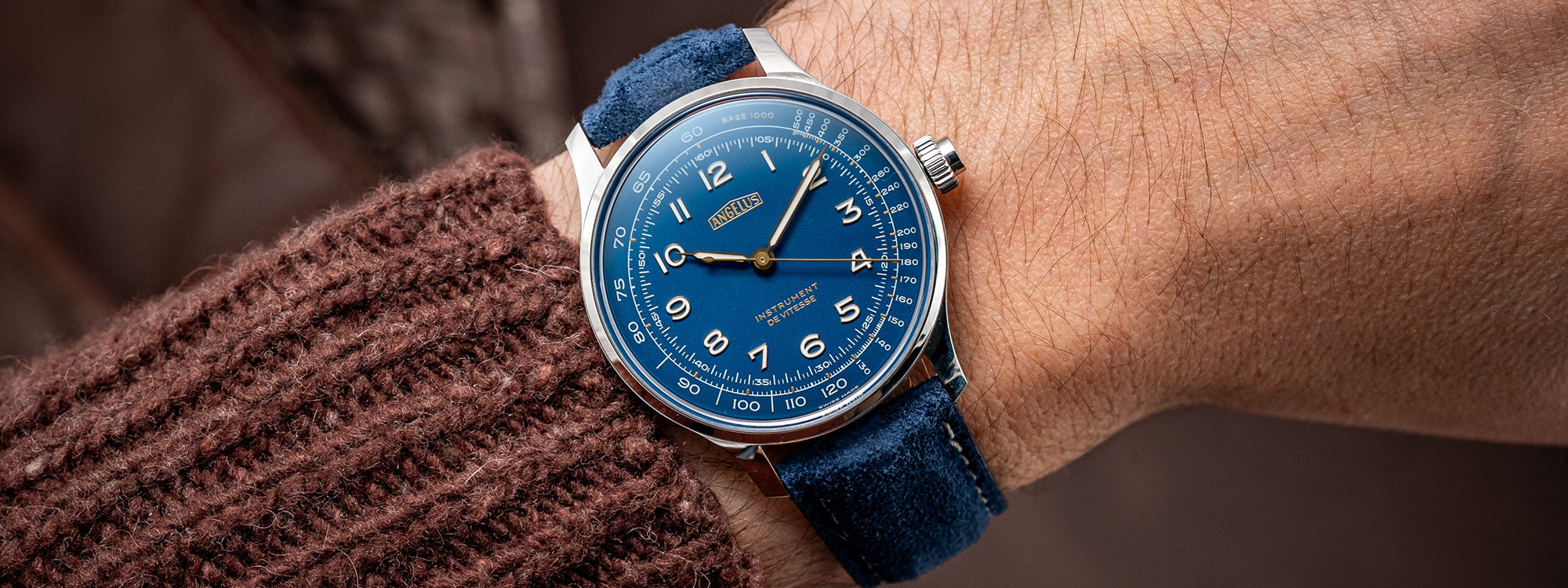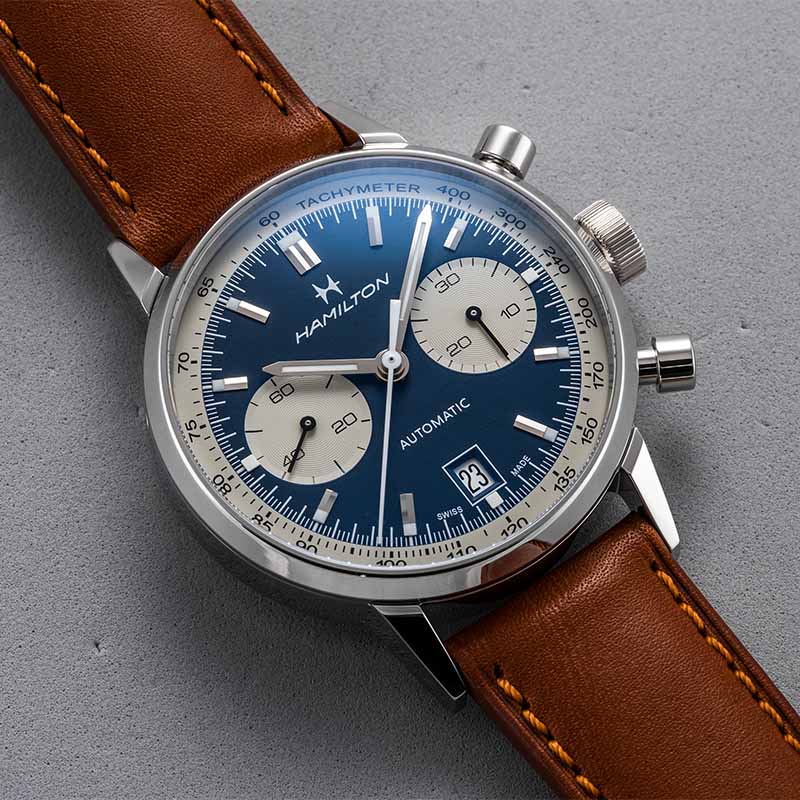Angelus is a watchmaker that many younger enthusiasts likely regard as a newcomer to the scene but actually brings to the table a rich heritage going all the way back to 1891 — as a maker of watches as well as some of the industry’s most legendary movements. Angelus calibers were used, for example, in the earliest Panerai Radiomir watches from the 1940s. Based in Le Locle, Switzerland, the firm was one of the first watchmakers to adopt the two-pusher chronograph design that had first been explored by Breitling. Its ChronoDato model, launched in 1942, and its successor in 1948, the ChronoDatoLuxe, remain among the most legendary grails for vintage chronograph collectors.

When Angelus resurfaced in 2015 — now owned by the prolific Swiss movement-maker La Joux-Perret, which is part of Japan’s Citizen Watch Group — the timepieces it chose to re-establish itself in the 21st-Century marketplace proved perplexing to many longtime collectors and armchair brand historians. Watches like the somewhat bizarre-looking, sci-fi-influenced U10 Tourbillon and the huge, skeletonized U50 Diver Tourbillon seemed to indicate that the revived Angelus brand was jettisoning much of its vintage appeal to explore more avant-garde frontiers. Starting in 2022, however, with the much-praised release of the ChronoDate models, heavily inspired by the 1942 ChronoDato, Angelus has signaled a renewed interest in mining its mid-century archives, particularly in its chronograph sweet spot.

The Instrument de Vitesse collection, which evokes the spirit of wristwatches made in the 1960s and ‘70s and designed with motorsports in mind, emerged in early 2024, with the first two 25-piece limited editions — one with an ivory-colored dial, the other with a classical black dial — generating enthusiast buzz at Watches & Wonders Geneva. Several months later, Angelus followed up those inaugural pieces with two more, both also limited to 25 pieces: the Instrument de Vitesse Silverstone, with a sleek gray dial, and the review watch that I was immensely fortunate to spend some quality time with recently, the blue-dialed Indianapolis edition.

Lots of chronograph watches, of course, lay claim to the DNA of automobile racing and dashboard elements in their design. But the Instrument de Vitesse lives up to its billing as “the purest expression” of a racing-focused chronograph, “designed for short bursts” rather than the many minutes and hours tallied by other, more well-known chronographs like the Rolex Daytona, TAG Heuer Carrera, and their legions of imitators and offspring. The rhetorical question being posed by Angelus with this watch seems to be something on the order of: “Why would you need a stopwatch that accumulates up to 12 hours of elapsed time if your goal is to time laps around a racetrack, which in motorsports should all fall within one minute?”

Taking a close look at the dial, you’ll notice a clean, streamlined aesthetic in keeping with that ethos. There are no subdials for elapsed minutes or hours and no running seconds tracked on either a subdial or a central hand. Instead, the watch offers simply an hour and minute hand, both with a golden finish and a sharply angular syringe-style shape, and a thin central hand, with the same polished gold finish, for chronograph seconds. The hour and minute hand point to the current time on elegant, gold-toned Arabic numeral appliqués; both the hands and numerals are coated with Super-LumiNova in their centers, which lends them a pale green glow in the dark.

A single pusher embedded in the center of the fluted crown brings the chronograph seconds hand to life, sending it skipping along the two concentric scales bordering the hour numerals: a graduated minutes scale marked in an elegant high-contrast font and, on the far periphery, the all-important tachymeter scale, graduated from 60 to 500 km/hr with a base metric of 1,000, aka one kilometer. If you are into timing races, you’ll know that this combination of elements makes it child’s play to record not only the exact time of a lap, to the nearest ⅙-second, but also the speed of a moving vehicle in km/hr (admittedly, this is more useful in Europe, or Canada, or anywhere but the U.S. where the metric system is used to record speeds). And even if you’re not into these calculations, it still makes the watch pretty cool. (If you're curious about how a tachymeter works, click here.)

The stainless steel case, with its combination of polished and brushed finishes (the former employed on most of the front-facing surfaces, the latter on the case middle), is also much more understated than that of your typical motorsport-evocative chronograph watch. It measures 39mm in diameter and just 9.27mm thick. And thanks to its narrow bezel; its nearly flat, box-shaped sapphire crystal; its relatively short, curving lugs; and most notably, the lack of pushers or crown guards to expand its weight and wrist presence, it wears even a bit smaller, in my opinion. The one concession to this overall streamlined design is the aforementioned monopusher button that extends from the center of the crown and makes the watch appear just a bit weighted to one side.

Another part of this watch’s retro appeal is the use of a hand-wound movement, Caliber A5000, which is produced exclusively for Angelus by its parent firm, La Joux-Perret. For a chronograph-equipped movement with monopoussoir functionality, it is exceptionally thin: just 4.2mm thick, which assists in the watch’s overall slender profile. The absence of subdials with separate totalizers helps here, as does the lack of a rotor, which would add thickness and also obscure some of the mechanism’s frankly beautiful decorative finishes. The latter include circular gaining on the palladium mainplate; chamfered edges and côtes de Genève on the bridges, also made from palladium; circular graining on the wheels, finished in 2N gold; and polished heads on the screws that dot the landscape of the movement. As far as I am aware, the use of palladium for these components is anything but mainstream, and it adds to the watch’s exclusivity.

The balance wheel in the lower center oscillates at 21,600 vph, or 3 Hz, standard for chronograph wristwatch movements made in the era to which this watch pays tribute. Also in evidence are two other classical chronograph elements, a column wheel and vertical clutch, which can be observed in action from the back once the one-minute stopwatch has been started, stopped and returned to zero. The barrel for the 42-hour power reserve is also visible in the upper right. Angelus has also addressed a common concern about manual-winding movements, i.e., the worry that one can “over-wind” the mainspring, by including a device that halts the crown when the movement is fully wound.

The wrist-hugging lugs connect the timepiece to a dark blue, nubuck calfskin strap, with high-contrast ecru stitching that picks up the muted tones of the print on the dial’s scales. Appropriately for such a vintage-inspired, era-specific watch, its closure is a classical steel pin buckle, with a polished surface that echoes the finishing on the case and an engraved Angelus logo. On the wrist, the strap and dial combination make for a very handsome monochromatic execution, and the former’s soft outer surface just begs you to run your fingers along its suede-like texture. I’ve never been in the cockpit of a 1970s race car but this material conjures up how those leather seats must have felt at the time.

The only quibble that I would imagine many enthusiasts would have about the Instrument de Vitesse would be how difficult it is to get one, as each of the editions so far (ebony, ivory, gray Silverstone and blue Indianapolis) has been very strictly limited to just 25 watches. (The rather high prices might be, at least in part, a direct result of that scarcity also, though the in-house La Joux-Perret movement, with palladium bridges, is also certainly a factor.) At an MSRP of $17,300, it is most assuredly a luxury item, but also, with its understated yet distinctly dashboard-oriented aesthetic, a perfect timepiece for refined racing enthusiasts who want to wear their passion on — or under — their sleeves.






















































0 Comments